How To Change Background In Corel Paintshop Pro X9
Creating Transparent Backgrounds with the Groundwork Eraser
The Background Eraser is a very effective tool to create a transparent background on your photos. We'll review how the regular Eraser tool works in comparison to the Background Eraser, and then prove you how to remove a background from ane photo and replace it with a background from another photo. Once yous master this technique, you lot volition be able to create amazing blended images.
Nosotros will start with this image of a pier. Open the sample image Pier.jpg in theEdit tab of PaintShop Pro.
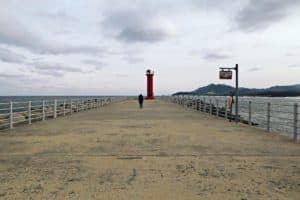
Let's quickly review the differences between the regularEraser and theBackground Eraser.
Select theEraser tool from theTools toolbar. In theProperty Bar, select a size of near100.
TIP: You tin can adjust the eraser size past entering an exact figure into theSize box on theHolding Bar, or past holding down theALT key and dragging your mouse up or down on your screen.

TheEraser is an all-or-goose egg tool, information technology doesn't distinguish between colors like theBackground Eraser does. On the Pier image, click and randomly move theEraser around to meet how it erases anything and everything.
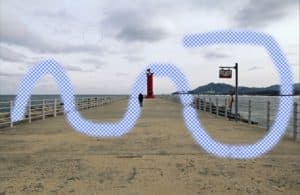
ClickUndo (Ctrl +Z) to return the photo to its original state.
TheEraser does have an selection calledSmart Border, which acts like a basic background eraser in that it automatically finds the edges of irregularly-shaped areas equally you erase. This can provide a shortcut if desired.
To see how this works, bank check theSmart Border option on theProperty Bar.

With yourEraser activated, identify well-nigh of the circle (including the centre eraser) into the sky portion but overlap the lower part of the circle into the sea.

Click and elevate from either direction forth the horizon where the sky meets the ocean. You can see that with theSmart Edge option enabled, theEraser does a good job of making a make clean distinction between the ocean and the sky.
Now that we've had a look at how theEraser works, let'south move on to theBackground Eraser. Click theUndo button (orCtrl+Z) to get rid of your eraser marks until you are back at your original epitome.
Select theBackground Eraser, which is in the same tool group flyout as theEraser. In theProperty Bar, set up theSize to200,Opacity to100, andTolerance to100. Keep remainder of the settings at their defaults. Nether theLimits drop-down list, selectFace-to-face. This will only erase colors that are connected to the primary sample area.
TIP: If you aren't able to suit theTolerance setting, bank check to make certain that theAuto Tolerance check box is not checked.

You lot will see that theBackground Eraser is represented by a big circle, with a small eraser icon right in the middle. It is important that yous continue the center icon from touching any area that you don't want to remove.
Starting time on the far left with the heart of the tool in the sky and the outer circle just overlapping into the sea. Click and drag horizontally from the left going straight to the right. Get up, over and around the lighthouse, being careful Non to place the center icon on the lighthouse itself.
If you lot make whatever mistakes, just useUndo (Ctrl+Z) and try once again. Until y'all get familiar with using theGroundwork Eraser, you might desire to do your erasing with a series of short strokes instead of one long stroke. This way, you won't lose all of your piece of work if you lot make a mistake and have toUndo.
Proceed to erase forth the pinnacle of the mountains and around the sign. With the brush settings every bit they currently are, there are some areas that you won't be able to easily erase, such every bit the superlative railing of the lighthouse or between the sign hinges. In a few steps below, we'll show you how to get at these areas.
If yous notice some erased areas are not fully transparent later your first laissez passer, merely get over them once more with theBackground Eraser.
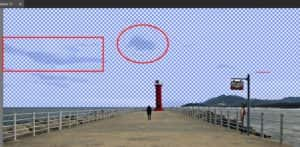
Once you take erased all of the sky, your paradigm will look like this:
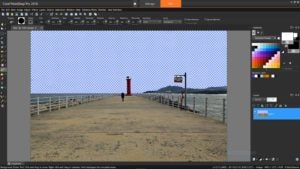
If you lot want to save this image with the heaven completely erased, make sure to salve it equally either a .PNG file or .PSPIMAGE file, to preserve the transparency you created.
Now that you've had a chance to endeavour out the basics of the Background Eraser, we're going to practise a fun projection to supervene upon the dull greyness background with a gorgeous sunset.You take 2 options on how to keep:
- If you want some more practise with theBackground Eraser, close the Pier image without saving any of the erasing you lot did, so re-open it to return to the original image (or you lot can undo as many times as necessary to return to the original prototype).
- If you want to preserve the erasing you have already done, only go along the modified Pier image open and go on with the adjacent steps beneath.
Open the sample prototype Sunset.jpg. Switch back to the Pier paradigm and copy it using one of the following methods:
- With thePan tool (hand icon) activated, correct-click on the Pier epitome and selectRe-create; or
- Go toEdit>Copy; or
- Use keyboard commandCtrl +
Switch to the Sunset image and paste the Pier image using i of the post-obit methods:
- Correct-click and selectPaste>Paste equally New Layer; or
- Go toEdit>Paste as New Layer; or
- Use keyboard commandCtrl+V.
The Sunset is now designated every bit theBackgroundlayer and the Pier prototype is on top of it.
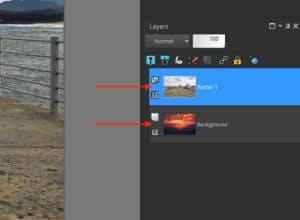
Select theGroundwork Eraser, leaving all the settings on theProperty Bar as they were set before. If you are starting over, erase the sky on the Pier image as you lot did previously. You will run into the sunset image now showing through the areas that you have erased. Again, yous volition still not exist able to erase inside the lighthouse's railing, nor betwixt the sign hangers…yet.

Select theDiscontiguous option under theLimits drib-down. As opposed to theContiguous option, theDiscontiguous pick will erase colors that still fall into the eraser's limits just are asunder from the main area.
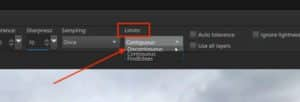
Using the same technique as before, erase effectually the lighthouse railing. The circle of eraser should reach in and now also erase what's within the railing.
Repeat this for inside the hinges of the hanging sign. Remember not to touch the center of the tool on either the lighthouse or the sign itself.

Finish erasing the rest of the heaven. Try using the following shortcut technique:
- Agree downwardly theShift key and click in the upper left corner of the sky
- While still holding theShift key, click in the upper right corner.
This will erase a strip of the Pier image all the style beyond and you should now come across a strip of sunset stretching all the fashion across the tiptop.
Keep erasing the sky of the Pier image until it is completely replaced by the sunset image backside it.
TIP: If you concord down your right mouse button while using theBackground Eraser, it will "unerase" or restore any parts that yous erased. This can be helpful if you lot've made a mistake but don't desire to utilizeDisengage and lose all of your erasing piece of work.

Groundwork Eraser Tool Settings
The post-obit is a quick overview of the settings and options for the Groundwork Eraser. You can notice more data in the PaintShop Pro Assistance files.
- Opacity — a lower setting erases pixels to partial transparency.
- Tolerance — determines how closely the selected pixels match the sampled pixel.
- Sharpness—specifies the softness of the erased edge. A softer castor crates anti-aliased edges.
- Sampling — specifies the basis on which pixels are erased. This control has the following options:
- One time — samples the betoken at which you first click and and then erases all matching pixels for the duration of the stroke.
- Continuous — samples continuously and erases all matching pixels information technology encounters, including foreground colors if the sampled pixel falls into the foreground area.
- BackSwatch — erases all pixels that match the current background color on the Materials palette
- ForeSwatch — erases all pixels that lucifer the electric current foreground colour on the Materials palette
- Limits — specifies whether erased pixels are adjacent to each other with the following options:
- Discontiguous — erases all pixels in the tool's path that lucifer the sampled pixels, even if they are nonadjacent. We used this on the lighthouse and the sign.
- Contiguous — erases only contiguous pixels that match sampled pixels. This setting would've skipped the areas inside the lighthouse and the sign.
- Find Edges — similar to Face-to-face, only meliorate for areas with abrupt edges where you want to continue the sharpness.
- Car Tolerance — determines what is erased based on the color range from the first colour you lot click on. You tin uncheck this manually set the tolerance level instead.
- Use all layers — samples data from all layers merged together. Only pixels in the current layer are erased. To sample information from the current layer just, y'all can unmark the check box.
- Ignore Lightness— ignores sharp differences in color lightness and saturation. You can marking this check box when the colors in the object that yous want to isolate are strongly saturated and the groundwork is unsaturated, or vice versa.
Source: https://learn.corel.com/tutorials/create-transparent-backgrounds/
Posted by: tiedemansumate.blogspot.com


0 Response to "How To Change Background In Corel Paintshop Pro X9"
Post a Comment